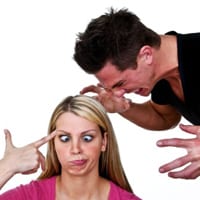I recently had the pleasure of sitting and waiting for a doctor’s appointment. I was up to date with my email, texts and the latest happenings at GoHorseShow and was bored. I looked around, and the only magazine left on the table was Ladies Home Journal. Making sure nobody was looking, I scooped up the magazine and headed right for ‘Can this marriage be saved?’
If you are not familiar with the column, it’s like a print version of something that could be a Reality TV show, and here is how it works. A couple goes to see a therapist. The woman draws first blood and tells her side of the story, then, the man gets his chance to get in a few digs and blow off some steam. Finally the therapist chimes in and provides some nuggets of wisdom that the couple can put into practice to save their relationship. That is, of course, unless the relationship is a complete train wreck, in which case, I would imagine the magic Rolodex with high profile divorce lawyers comes into play.
I began to realize that the relationship between riders and trainers is similar to a marriage, and thought it would be interesting to do couples therapy GoHorseShow style, so welcome to ‘Can this client be saved?’
Note: The names have been changed to protect the innocent. The Trainer’s name is Pat because I am not trying to throw a specific gender of trainer under the bus.
Her Turn
I am so frustrated, I am ready to quit showing! All my trainer does is yell at me, in front of other people when I am in the warm up pen and when I am showing. Sometimes I don’t really understand what Pat is telling me to do, but Pat keeps saying the same thing, over and over, and Pat’s voice gets louder and louder. It’s not that I don’t hear Pat, I don’t get what Pat is asking me to do. At our last show, it was really embarrassing, and I feel like a moron. When I am getting instruction, I hear things like, “Don’t pick on his face” “Don’t let him speed up” or last week I got a lot of “ Don’t use your hands, if you aren’t using your leg”. What is that suppose to mean? To be honest, sometimes I feel like yelling back. Does Pat really think I am doing this stuff on purpose? When I am showing, Pat stands on the rail and kind of barks orders at me, to the point where I almost have to tune them out. The way I see it is once I get in the show pen, it is up to me, since after all, I am riding the horse, aren’t I? It is distracting, and actually breaks my concentration. If I am that stupid and need all kinds of help in the show pen, then maybe I am not ready to show in that class.
Pat’s Turn
I think that Amy is a great rider, I don’t know why she doesn’t have any confidence. At home, things seem to be OK, but when we go to the shows, there seems to be a lot of tension. I try and spend as much time as I can with her, but I have other clients and I can’t be two places at once. I think she thinks I am picking on her, but actually, I am tough on her that because she is a good rider, and I really think she ‘gets it’. It just seems like at shows, she gets nervous, and doesn’t do what I am telling her to do.
At our last show, I rushed over to help her with her class, and saw she was just kind of sitting there, and was letting her horse kind of do whatever he wanted to. When I told her to use her leg and her hand at the same time, she looked at me and just kept on doing what she was doing. If she isn’t going to listen to me, why should I hurry up and get over to help her, when I could be helping somebody else. Maybe she needs a different trainer, I don’t know what to do. I don’t want her to leave or quit riding, but it isn’t much fun for either of us right now.
Counselor’s Turn
Holy Lack of Communication Batman! Right now, hearing these two go at is more irritating than listening to a cat running up a chalkboard, but with a few simple rules of clean communication, these two will be on the same page and in perfect harmony.
This couple, like most horse show couples, is dealing with two simple issues:
1. Lack of proper pre-competition planning.
2. Coaching is not being understood by the rider.
The good news is, each person can take responsibility for fixing these issues, so when they work through them together, they will not only have a much more effective relationship, but they will have more respect for one another, and may even start having fun again!
Lack of Pre-Competition Planning
99% of most issues can be fixed by gaining upfront agreement on how things are going to happen. In this case, if Pat is busy, then Pat needs to let Amy know that she is on her own during her class. Once that is established, Amy can then sit down with Pat and discuss the game plan and then set one or two performance goals for the class. An example would be that Amy would make sure her horse maintains the correct speed for the entire class. In doing so, that would presuppose that she riding correctly – the way she rides at home.
Other things that can go into the Pre-Competition plan would involve how and when Amy would warm up, and how Pat would be providing her with feedback before and during her class. If Amy is sensitive to Pat’s style of coaching, then it is her responsibility to let Pat know that- well in advance of a show. This way, they can figure out the best way for both of them to work together to get the best result. For example, sometimes having a trainer point to their leg instead of telling the rider to use their leg may be more effective for some riders. Everyone is different, and if something isn’t working for either a rider or a trainer, having an honest open dialogue and coming up with a plan that works for everyone will eliminate tension and frustration between riders and trainers.
Coaching not being understood by the rider
Tell me once, shame on me. Tell me twice, shame on you. Tell me three times? It’s time for a sidebar. If the same instruction is being delivered without the desired response that’s your proof that something isn’t getting through. Amy felt that Pat kept saying the same words, but when she did not understand, Pat just got louder. This is called the tourist strategy. You know, when a tourist is asking for directions from a non-English speaking person. When the non-English speaker does not understand the tourist, the tourist just talks louder and louder. This is about as effective as waving at Stevie Wonder to get his attention. It’s not that Amy doesn’t hear, Pat, she does not understand Pat and increasing the decibel level of the same words is not going to magically make Amy understand what Pat wants. After three tries, it is time to huddle up and have a quick conversation. Maybe Amy learns visually, and having Pat show her what she is doing and then show her how to do it correctly is all it will take for her to ‘get it’.
Another possibility is that although Pat was telling Amy to use her leg and her hand, that’s not how she heard it. What she heard was instruction that started with Don’t, Stop or Quit which falls into the ineffective communication category, and here’s why. If I tell you not to think of a bay horse, as soon as the words leave my mouth, most of you will have an image of something resembling Harley D Zip or Allocate Your Assets (my personal favorite). In general, and especially under stress, the part of our brain that needs to understand the instructions can’t process the ‘not’. In order to not think of a bay horse, we first create the image in our mind and then we can take the next step and not think about it. If you want people to do something, then you need to tell them how you want it, and if a rider only hears what they shouldn’t be doing, it is their responsibility to stop, ask for clarification and understand what specifically the trainer is asking for.
Next Steps
The plan was for Pat and Amy to set a convenient time to talk and to work through roles and responsibilities at the shows. They also came up with some nice hand signals that Pat can use when coaching her at shows. If Pat is busy, Amy is perfectly happy to show on her own, so that takes some of the pressure off of Pat.
Follow Up
Once Amy and Pat were able to sit down and come up with their game plan, things started changing for the better, and at their last show, they started having fun again. If your client/trainer relationship needs a little makeover, think about what you can do to open the lines of communication. You may be surprised to find out how a simple conversation can take any relationship from frustrating to fulfilling.
Kirsten Farris is a regular contributor to GoHorseShow.com and a Certified Sport Consultant, Certified Equestrian
Fitness Trainer, and the Author of The Workbook for the Equestrian
Athlete – A Guide to Showring Success. For more information contact her
at: kirsten@equestrianathlete.com
© 2011








